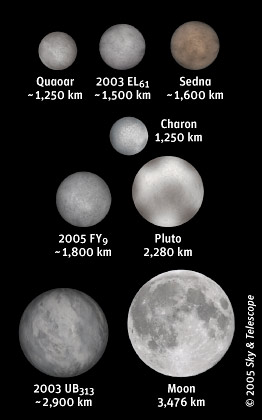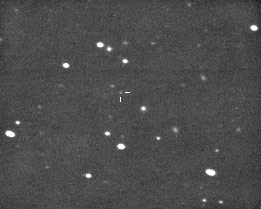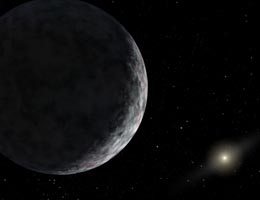
These three discovery images, each taken 1.5 hours apart on the night of October 21st, 2003, show the slight motion of the large, distant object 2003 UB313 in the sky.
Courtesy M. Brown (Caltech), C. Trujillo (Gemini Observatory), and D. Rabinowitz (Yale University)
After 75 years of speculation and false leads, it has finally happened. A team of astronomers using the 48-inch Samuel Oschin Telescope at Palomar Observatory and the 8-meter Gemini North telescope on Mauna Kea, Hawaii, has discovered the largest Kuiper Belt object (KBO) ever.
It is bigger than Pluto, the 9th planet.
The object, designated 2003 UB313, is currently 97 astronomical units (Earth-Sun distances) away — more than twice Pluto's average distance from the Sun. This makes it the farthest object ever seen in the solar system. It is a scattered-disk object, meaning that at some point in its history, an encounter with some massive object moved it into its highly inclined (44°) orbit. It's currently glowing at magnitude 18.9 in the constellation Cetus. Its high inclination is the only reason it wasn't discovered years ago; no one was looking for planets so far from the plane of the solar system.
Discoverers Michael E. Brown (Caltech), Chad Trujillo (Gemini Observatory), and David Rabinowitz (Yale University) first imaged the object on October 21, 2003, but didn't see it move in the sky until they reimaged the same area 15 months later, on January 8, 2005. Working backward from there, the astronomers have found old images of 2003 UB313 in much earlier surveys, allowing them to determine its orbit accurately. The object turns out to be currently near aphelion (its farthest from the Sun) in a very elliptical orbit. It ranges as close as 38 a.u. to the Sun in a 557-year orbit.

S&T Diagram:: Gregg Dindermann
"We tried looking at it with the Spitzer Space Telescope and didn't detect it. So we have an upper limit on the size. It can't be any more than 3,000 kilometers across," says Brown. But the lower limit derived from its brightness — even by assuming its surface is 100 percent reflective — still makes it larger than Pluto, which is 2,250 km (1,400 miles) across.
"It's a big sucker!" says Brown.
Preliminary near-infrared spectra, obtained by team member Chad Trujillo at the 8-meter Gemini North telescope, show methane ice on the object's surface — much like the spectrum of Pluto, which is also dominated by methane ice in the near infrared. Trujillo says in a Gemini press release, "It is clear that [2003 UB313] is very similar to Pluto in both size and composition, at least upon first glance." Pluto is about 30 percent reflective. Methane ice is unusual and suggests a primitive surface that has never been warmed much since the formation of the solar system. "To date," notes Trujillo, "no one has seen methane on any other Kuiper Belt object, only on Pluto and Neptune's moon Triton."

They did it! Just hours after its existence was announced, Gianluca Masi and Roger Wilcox imaged 2003 UB313 around 5:00 Universal Time on the morning of July 30th. It's the faint object at center marked by white ticks. Masi writes, 'This 5-minute CCD image was grabbed remotely using the 36-centimeter [14-inch] SoTIE Telescope in Las Campanas, Chile. North is up, east is left. The field of view is about 8.5 by 7 arcminutes.' They also made a blink movie of the object showing its motion on the sky in 3.5 hours.
Courtesy Gianluca Masi.
Update October 2005: 2003 UB313, now nicknamed Xena, is in central Cetus, currently well up in the south late at night. Ambitious CCD imagers with setups capable of seeing to 19th magnitude can shoot for it at the following 2000.0 coordinates (accurate to a couple of arcminutes depending on the date):
Early October: R.A. 1h 37.7m, dec. –5° 34'.
Late October: R.A. 1h 37.2m, dec. –5° 36'.
Early November: R.A. 1h 36.7m, dec. –5° 39'.
Late November: R.A. 1h 36.1m, dec. –5° 40'.
Early December: R.A. 1h 35.7m, dec. –5° 40'.
Late December: R.A. 1h 35.4m, dec. –5° 39'.
Early January: R.A. 1h 35.2m, dec. –5° 37'.
Late January: R.A. 1h 35.2m, dec. –5° 34'.
And a Second Big KBO
If that weren't enough, a second big Kuiper Belt discovery also made news the same day: 2003 EL61. A team of astronomers at the Sierra Nevada Observatory in Spain reported their discovery (details here) to the Minor Planet Center in Cambridge, Massachusetts. It had been spotted by Brown and his team more than a year ago, but, as Brown notes on his website for this object, "There is no question that the Spanish group is rightly credited with discovery. We could have announced the object earlier, but we took a chance that no one else would find it while we were awaiting our observations from the Spitzer Space Telescope. We were wrong!"
Located about 52 a.u. away and now situated in eastern Coma Berenices, 2003 EL61 is about 70 percent of Pluto's diameter.
Moreover, by a great stroke of luck, 2003 EL61 has a tiny satellite revolving around it, at an apparent distance of about 1.5 arcseconds. According to Brown's group, the satellite completes an orbit every 49 days in a nearly circular orbit some 49,500 km (30,760 miles) from the main body. The satellite's orbit has allowed the team to determine the parent object's mass: about a quarter that of Pluto.
Based on a quick look at the Spitzer observations of 2003 EL61, Brown believes that the infrared spectrum is dominated by water ice. "It looks much like [Pluto's moon] Charon," he notes.

An artist portrays 2003 UB313, an object orbiting the Sun that is larger than Pluto. The discoverers of this distant, frozen world are calling it the solar system's 10th planet.
Courtesy NASA / JPL-Caltech.
 0
0
Comments
You must be logged in to post a comment.